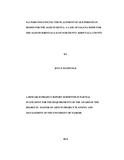| dc.description.abstract | As population in Kenya increases the utilization of homes for the old is an area of
concern. In Kenya the number of older persons, 60 years and above has risen
dramatically, from a modest number of 270,000 1949 to 1.9 million in 2009. The
demographic shift towards increased older persons in society has been accompanied
by rapid urbanization, shifting attitudes within communities and population
movements. In particular, the increased movement of younger persons from rural to
urban areas in search of employment has led to major changes in family structures,
resulting in the breakdown of the extended family support systems to older persons in
society with its in-build traditional social protection systems. On the other hand rural
urban migration has also created a segment of older persons in urban areas who face
peculiar challenges. Therefore this study investigated the factors influencing
placement of old persons in homes of the aged in Kenya. The study was carried out in
Sagana home for the aged in Kirinyaga East in Kirinyaga County. The study focused
on; health, family structure, access to caregivers and income of the old persons and
how they influenced placement of old persons in homes for the aged. The study
employed a descriptive survey research design. The target population under study was
all the 109 people who are in Sagana home for the aged including the old persons, the
social workers and the committee members. The study was conducted on the entire
population. Data was collected by use of structured interview. The data was analysed
quantitatively and qualitatively and presented using frequencies, and regression
analysis. Statistical Package for Social Sciences (SPSS) version 21 was used to aid in
generating a summary of results which were represented in form of charts and tables.
The study found out that 50% of the members of Sagana home for the aged said that
old person were placed in the home due to disability. The study found that old
peoples’ health explained 25% of the placement of old persons in home for the aged,
income explained 1.3%, access to caregivers 2.9% and family structure explained
14.6% of placement of old persons in homes for the aged. The researcher
recommends that there should be a policy to facilitate allocation of funding to
homes for the aged since the homes are taking care of the elderly disabled with no
support from the government. | en_US |

